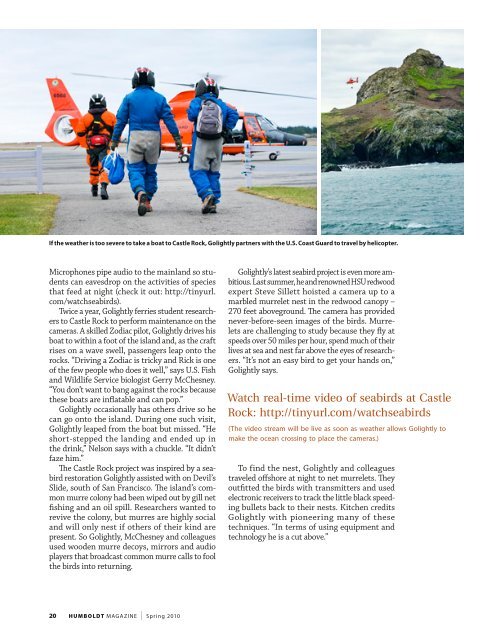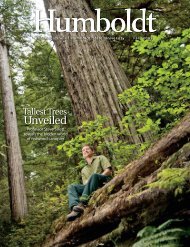Download Now - Humboldt Magazine - Humboldt State University
Download Now - Humboldt Magazine - Humboldt State University
Download Now - Humboldt Magazine - Humboldt State University
You also want an ePaper? Increase the reach of your titles
YUMPU automatically turns print PDFs into web optimized ePapers that Google loves.
If the weather is too severe to take a boat to Castle Rock, Golightly partners with the U.S. Coast Guard to travel by helicopter.<br />
Microphones pipe audio to the mainland so students<br />
can eavesdrop on the activities of species<br />
that feed at night (check it out: http://tinyurl.<br />
com/watchseabirds).<br />
Twice a year, Golightly ferries student researchers<br />
to Castle Rock to perform maintenance on the<br />
cameras. A skilled Zodiac pilot, Golightly drives his<br />
boat to within a foot of the island and, as the craft<br />
rises on a wave swell, passengers leap onto the<br />
rocks. “Driving a Zodiac is tricky and Rick is one<br />
of the few people who does it well,” says U.S. Fish<br />
and Wildlife Service biologist Gerry McChesney.<br />
“You don’t want to bang against the rocks because<br />
these boats are inflatable and can pop.”<br />
Golightly occasionally has others drive so he<br />
can go onto the island. During one such visit,<br />
Golightly leaped from the boat but missed. “He<br />
short-stepped the landing and ended up in<br />
the drink,” Nelson says with a chuckle. “It didn’t<br />
faze him.”<br />
The Castle Rock project was inspired by a seabird<br />
restoration Golightly assisted with on Devil’s<br />
Slide, south of San Francisco. The island’s common<br />
murre colony had been wiped out by gill net<br />
fishing and an oil spill. Researchers wanted to<br />
revive the colony, but murres are highly social<br />
and will only nest if others of their kind are<br />
present. So Golightly, McChesney and colleagues<br />
used wooden murre decoys, mirrors and audio<br />
players that broadcast common murre calls to fool<br />
the birds into returning.<br />
Golightly’s latest seabird project is even more ambitious.<br />
Last summer, he and renowned HSU redwood<br />
expert Steve Sillett hoisted a camera up to a<br />
marbled murrelet nest in the redwood canopy –<br />
270 feet aboveground. The camera has provided<br />
never-before-seen images of the birds. Murrelets<br />
are challenging to study because they fly at<br />
speeds over 50 miles per hour, spend much of their<br />
lives at sea and nest far above the eyes of researchers.<br />
“It’s not an easy bird to get your hands on,”<br />
Golightly says.<br />
Watch real-time video of seabirds at Castle<br />
Rock: http://tinyurl.com/watchseabirds<br />
(The video stream will be live as soon as weather allows Golightly to<br />
make the ocean crossing to place the cameras.)<br />
To find the nest, Golightly and colleagues<br />
traveled offshore at night to net murrelets. They<br />
outfitted the birds with transmitters and used<br />
electronic receivers to track the little black speeding<br />
bullets back to their nests. Kitchen credits<br />
Golightly with pioneering many of these<br />
techniques. “In terms of using equipment and<br />
technology he is a cut above.”<br />
20<br />
HUMBOLDT MAGAZINE | Spring 2010




